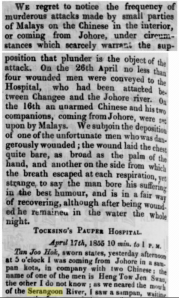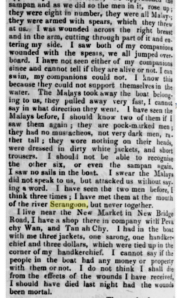Au Kang (Hougang) 后港
Au Kang (Hougang, variant: How Kang), a former Kangkar settlement established at the end of Sungei Serangoon. An Index in Romanised Hokkien and Cantonese to ” The Chinese Names of Streets and Places in Singapore” published in the Journal of the Straits Branch of the Royal Asiatic Society in December 1906 revealed that Au Kang was the Chinese synonym for Serangoon (variant: Sirangoon).
According to a survey published in the Straits Times on 18 May 1855, Au Kang was settled by 243 coolies. A letter printed on The Straits Times, 11 November 1856 by Philip Marquad complaining of the poor location of the Siglap police station he was in-charged of, revealed that the “Jungle inhabitants” at Howkang and Lowe (i.e. Low or Lau) Chu Kang Baru districts conveyed their produce to Town by Serangoon Road.
The Wikipedia entry on Hougang reports that at Hougang Street 21, there was a well that is still identified as the tua jia ka well structure. This well identified the Teochew village of tua jia ka which means the “foot of a big well”. In the past, the village was a popular place for food, street wayangs, itinerant Chinese medicine men and story tellers spinning yarns. Au Kang was once a pig farming area until the 1990s.
Pre-1860 newspaper reports
Early press coverage on the Au Kang/Serangoon reveal it to be an almost lawless area.
The Singapore Free Press reported on 20 February 1845 an investigation ordered by Tan Tock Seng (Justice of Peace) when a group of Chinese were seized for transporting on a bullock cart a coffin with a badly decomposed body. The deceased, a sawyer at Serangoon, was claimed to be found dead in a swamp after he left home to buy arrack for the Chinese New Year a week earlier. On inspection, his skull was found marked with cuts from heavy sharp cutting instrument.
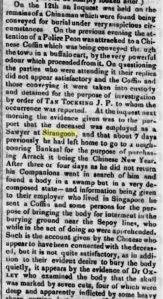
The Singapore Free Press reported on 28 December 1849 a robbery at a Chinese plantation near Serangoon. The inhabitants were attacked by a gang, which took away the working tools.
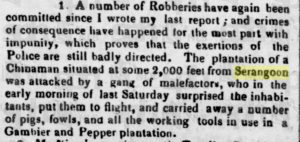
The Singapore Free Press on 7 June 1849 carried the news of the murder of a Chinese. The victim’s body was “cut in the most horrid manner, and the hands tied behind the back”.
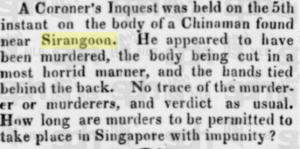
The Singapore Free Press reported 25 January 1850 of a Lim-ah-kin who was assaulted by his own coolies in a pepper plantation in Serangoon and robbed of clothes and money.

The Singapore Free Press on 3 May 1850 identified Serangoon as one of several areas where gambling was carried out on “a most extensive scale”.
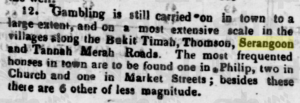
According to another case reported on The Singapore Free Press on 18 October 1850, five Chinese found their stolen boat and three thieves at Serangoon River. However they were stopped on their way to the police station by Tan Ah Tow, the head of a secret society. When the five Chinese appeared at the Kongsi House at Rochor days later, they were ordered to return the thieves some weapons left on the boat (but allowed to keep the boat), and beaten. Tan Ah Tow was charged in court and sentenced to 6-months imprisonment and a $200 fine. The reporter believed that the fine amount would be raised through a 1 cent per head levy on the 20,000 society members.
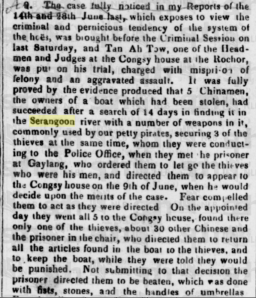
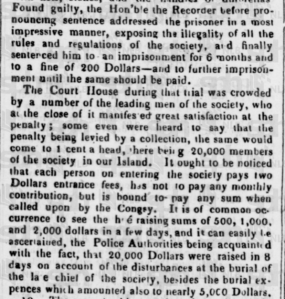
The Singapore Free Press reported 6 December 1850 of the death of a resident in Serangoon named Tan Soo in hospital from a severe wound received in the abdomen.
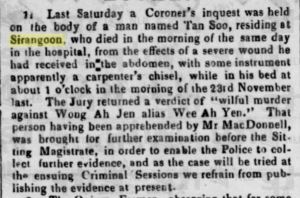
The Straits Times reported on 24 August 1852 the dismissal and forfeiture of pay of two police peons who refused to accompany their colleague to aid a Javanese mandoor and two coolies, who were murderously attacked in a plantation at Serangoon. Read full article here.
The Straits Times, 24 August 1852 reported of a Chinese vegetable gardener and his wife who were gagged and robbed in their house in Serangoon. The local police constable was also reported to be aware of two cases of gambling, but did not intervene due to the large number of people involved and the small size of his party.
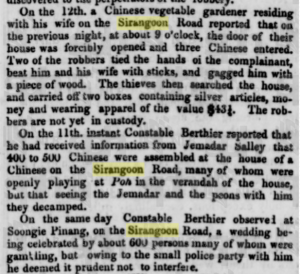
An over-night secret society meeting involving a large but unknown number took place at Toa Payoh in the Serangoon district, according to The Straits Times, 19 October 1852. Swearing-in of new members was suspected, although the police was ignorant of the purpose of the assembly.
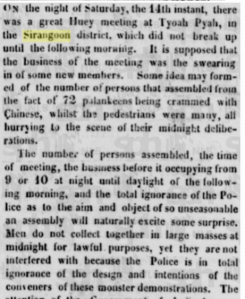
Read full article here.
The Straits Times, 10 June 1856 reported the kidnapping of a Christian Chinese adult in Serangoon village. It coincided with an increase of kidnapping of children in Singapore town, who were taken custody in Johore until ransom was paid.
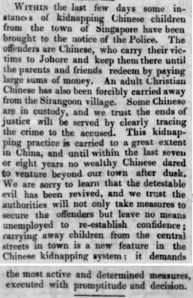
The request of Geo. Wahab, the Deputy Supt of Police in Charge, to the Municipal Committee to build four police stations in Buddoo (Bedok), Serangoon, Sungei Kranji and Chan Chu Kang was published on The Straits Times, 15 July 1856.
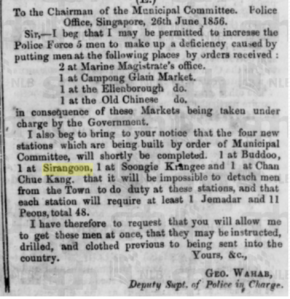
Tiger attacks were regularly reported in the Serangoon in the late 1840s and early 1850s, which might have resulted from an expansion of human activities and reduction of jungle in the area.
Singapore Free Press, 7 December 1847
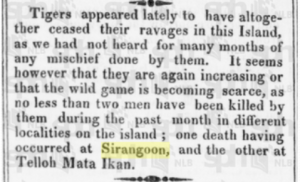
The Straits Times, 29 March 1848
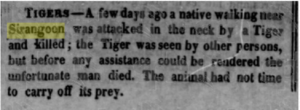
The Straits Times, 23 May 1849
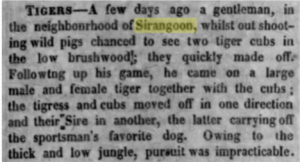
The Straits Times, 13 June 1849
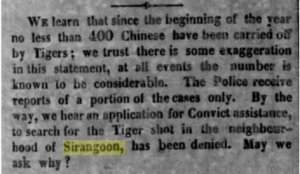
The Singapore Free Press 25 July 1851
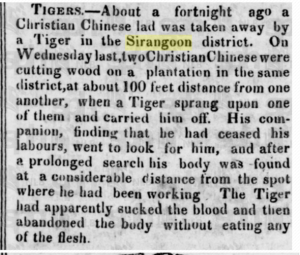
The Singapore Free Press 5 December 1851
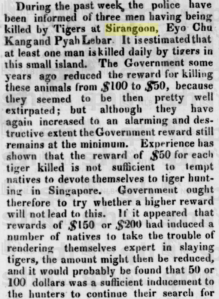
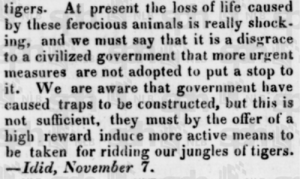
The Straits Times, 16 November 1852

On 21 February 1851, The Singapore Free Press reported the Serangoon (Au Kang) area to be affected by the anti-Catholic riots carried out by the Triad.
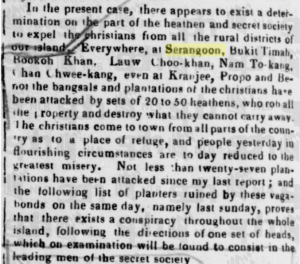
Read full article here.
The Singapore Free Press reported a week later 28 February 1851 of simmering unrest despite mediation by an unnamed rich Chinese merchant. Muskets, casks full of powder and rice were despatched by Serangoon River to Tan Chu Kang, where chiefs of the anti-Catholic riots were gathered. Meanwhile a Christian planter named Pung Ah Chin was robbed near Serangoon Road by a gang of ten armed Chinese.
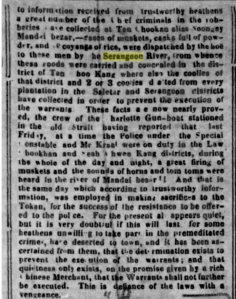
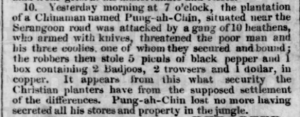
Read full article here.
Serangoon River was also plagued by frequent attacks of small parties of Malay.
The Straits Times reported on 9 July 1850 of an attack on two Malay boatmen and their three passengers (two Klings and one Chinese) at the entrance of Serangoon River by a large sampan of 13 Malays, two or three armed with spears. They were stripped of their clothes, some rice and working tools. One of the boatmen and Kling were speared to death, while the rest managed to escape.
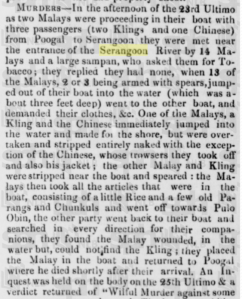
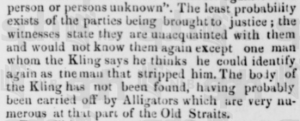
The Straits Times reported on 28 January 1851 that a coolie and a boatman, both with the surname Eyo (Yeo), were robbed and killed at Serangoon River. They were returning by boat to Pasir Ris with some rice and silver dollars after transporting gambier from a plantation there. One of the bodies was found with kris wounds.
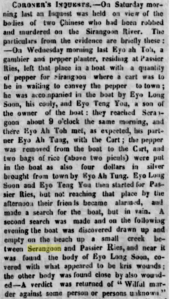
The Straits Times published on 1 May 1855 the statement of a Tan Joo Hok, a merchant from New Bridge Road who was attacked and robbed on his way back from Johore by a sampan of eight Malays. Two of his companions were missing after the incident. He identified two of the assailants to be familiar faces at a Serangoon River.
